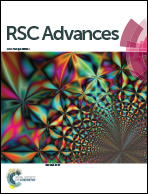Mesoporous NiCo2O4 nanoflower constructed from nanosheets as electroactive materials for dye-sensitized solar cells†
Abstract
Binary metal compounds with a spinel structure could improve the electron transport, activating adsorption and active sites for electrocatalytic reaction. Furthermore, the electrocatalytic activity of electroactive materials also depends on their morphology and nanostructure. Herein, this work reported the fabrication of NiCo2O4 mesoporous nanoflowers and mesoporous nanospheres and their application as promising counter electrode (CE) electrocatalysts in dye-sensitized solar cells (DSSCs). The as-prepared NiCo2O4 mesoporous nanoflower contains abundant open space between nanosheets, generating the 3D porous nanostructure. When investigated as CE materials, NiCo2O4 nanoflowers exhibited high charge-transfer ability and intrinsic catalytic activity. The DSSC with NiCo2O4 nanoflowers displayed a much higher power conversion efficiency (PCE) of 7.32% than that based on the NiCo2O4 nanosphere CE (PCE = 5.58%), even comparable with that of commercial Pt CE (7.54%).



 Please wait while we load your content...
Please wait while we load your content...